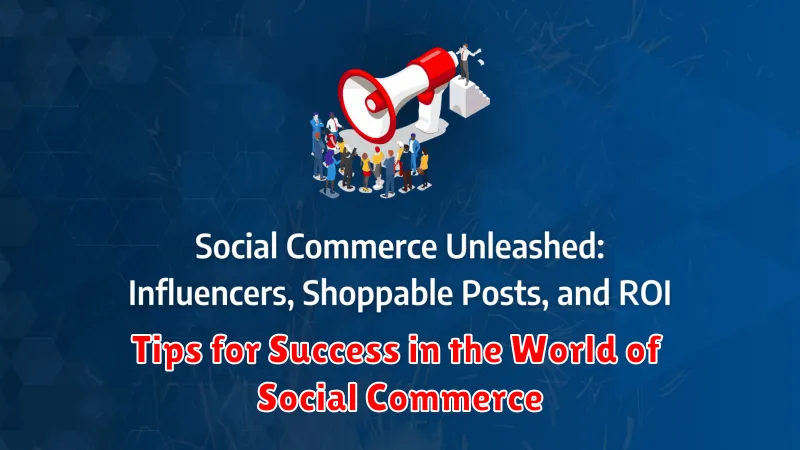In today’s digital age, social media has transformed from a platform for connection into a powerful engine for commerce. Social commerce leverages the vast reach and engagement of social media platforms to drive sales and build brand loyalty. This innovative approach allows businesses to seamlessly integrate product discovery, shopping experiences, and customer service directly within the social media environment. Understanding the power of social commerce is essential for businesses seeking to thrive in the competitive modern marketplace. This article explores the strategies and techniques to effectively harness the potential of social media to sell more products and achieve significant business growth.
From crafting compelling social media content that resonates with your target audience to leveraging influencer marketing and utilizing effective advertising strategies, there are numerous ways to capitalize on social commerce. This article provides a comprehensive guide to optimizing your social media presence for sales, including actionable tips on selecting the right platforms, building a strong brand community, and utilizing social commerce tools to streamline the customer journey. Discover how to harness the power of social commerce and transform your social media channels into dynamic sales generators.
What is Social Commerce and Why is it Important?
Social commerce is the process of selling products or services directly through social media platforms. It’s more than just posting product links; it involves creating a seamless shopping experience within the social media environment itself. This can include features like in-app checkout, shoppable posts, and interactive product displays.
Its importance lies in its ability to meet customers where they already are. People spend a significant amount of time on social media, and social commerce capitalizes on this by removing the friction of redirecting to external websites. This leads to increased brand visibility, improved customer engagement, and ultimately, higher conversion rates.
Social commerce leverages the power of social proof through reviews, comments, and shares, influencing purchasing decisions. It also offers valuable data and insights into customer behavior, preferences, and trends, allowing businesses to refine their marketing strategies.
Choosing the Right Social Media Platforms for Your Business
Selecting the right social media platforms is crucial for social commerce success. Target audience is the primary factor. Where do your potential customers spend their time online? Analyzing demographics and online behavior will guide your platform choices.
Platform features also play a significant role. Instagram is highly visual, making it ideal for visually appealing products. Facebook’s extensive user base allows for broad reach. Pinterest is excellent for product discovery, while TikTok’s short-form video format engages a younger audience. Consider which platforms best showcase your product type and brand personality.
Finally, assess your resources. Managing multiple platforms effectively requires time and effort. Start with one or two platforms and expand as your team and strategy develop. Focusing your efforts ensures a more impactful presence on each chosen platform.
Creating a Seamless Shopping Experience on Social Media
A frictionless shopping experience is crucial for converting social media browsers into buyers. Minimize the steps required to complete a purchase. Streamlined checkout processes are key. Customers should be able to buy directly within the platform whenever possible.
Mobile optimization is paramount. Ensure your social commerce setup is fully responsive and functions flawlessly on all devices. A poor mobile experience can lead to abandoned carts and lost sales.
Provide clear product information. High-quality images, detailed descriptions, and customer reviews build trust and encourage purchases. Size guides, color options, and other relevant details should be readily accessible.
Offer various payment options to cater to different customer preferences. Secure payment gateways are essential for building confidence and protecting sensitive data. Consider offering popular methods like PayPal, Apple Pay, and credit card processing.
Engaging Your Audience and Building a Strong Social Media Community

Engaging your audience is crucial for social commerce success. A strong community fosters trust and loyalty, driving sales organically. Active communication is key. Respond to comments and messages promptly and participate in relevant conversations.
Content should be valuable and relevant to your target audience. Share informative posts, behind-the-scenes glimpses, and user-generated content. Run contests and polls to encourage interaction. Ask questions and actively solicit feedback.
Community building requires consistent effort. Create a consistent brand voice and personality across platforms. Host live Q&A sessions or product demonstrations. Collaborate with influencers to expand your reach and build credibility.
By fostering authentic connections and providing valuable content, you can cultivate a thriving social media community that drives sales and supports long-term business growth.
Running Effective Social Media Ads for Sales Conversions
Social media advertising offers a powerful way to boost your social commerce efforts. Targeting the right audience is crucial. Utilize platform-specific targeting options, such as demographics, interests, and behaviors, to ensure your ads reach potential customers.
Crafting compelling ad creatives is essential for grabbing attention. Use high-quality images or videos and write concise, persuasive copy that highlights the benefits of your products. A clear call to action, like “Shop Now” or “Learn More,” encourages immediate engagement.
A/B testing is crucial for optimizing your ad campaigns. Experiment with different ad formats, visuals, and copy to determine what resonates best with your target audience. Continuously analyze your campaign performance metrics, such as click-through rates and conversion rates, to refine your strategy and maximize your return on investment.
Retargeting campaigns can effectively re-engage users who have previously interacted with your brand or products. By showing them tailored ads based on their past behavior, you can increase the likelihood of conversions.
Leveraging Influencer Marketing to Reach a Wider Audience
Influencer marketing is a powerful tool for expanding your reach in social commerce. By partnering with relevant influencers, you can tap into their established audience and build trust with potential customers.
Choosing the right influencers is crucial. Look for those whose audience aligns with your target market. Relevance over reach is key. A smaller, highly engaged audience is often more valuable than a large, passive one. Consider micro-influencers who have a dedicated following in your niche. Their authentic connection with their audience can translate into higher conversion rates.
Transparency and authenticity are paramount in influencer marketing. Ensure any sponsored content is clearly disclosed. Encourage influencers to integrate your product organically into their content, rather than relying on forced or generic promotions.
Tracking Your Social Commerce Performance and Making Data-Driven Decisions
Tracking your social commerce performance is crucial for understanding what’s working and what’s not. By analyzing key metrics, you can make informed decisions to optimize your strategy and boost sales.
Start by monitoring your conversion rates. This metric reveals how effectively your social media efforts are translating into actual purchases. A low conversion rate might indicate a problem with your product offering, pricing, or checkout process.
Next, analyze your engagement metrics. Track likes, comments, shares, and click-through rates to gauge audience interest and content effectiveness. High engagement often correlates with increased brand visibility and potential sales.
Pay attention to your reach. Understanding how many unique users are seeing your content helps determine the effectiveness of your targeting and promotion strategies.
Finally, regularly review your return on investment (ROI). By calculating the profit generated from your social commerce activities, you can assess the overall financial success of your strategy.
Tips for Success in the World of Social Commerce

Optimize your social media profiles. Ensure your profiles are complete and professional, with high-quality images and a clear brand voice. A consistent brand identity helps build trust and recognition.
Engage with your audience. Respond to comments and messages promptly and participate in relevant conversations. Building a strong community around your brand fosters loyalty and encourages engagement.
Use high-quality product photography and videos. Showcase your products in the best possible light to attract attention and drive sales. Compelling visuals are crucial for grabbing attention in a fast-paced social media environment.
Run targeted advertising campaigns. Utilize the targeting options available on social media platforms to reach the right audience with your ads. Precise targeting maximizes your ad spend and improves ROI.
Analyze your results and adapt your strategy. Regularly track your social commerce performance metrics to identify what’s working and what’s not. Data-driven insights are key to continuous improvement.

